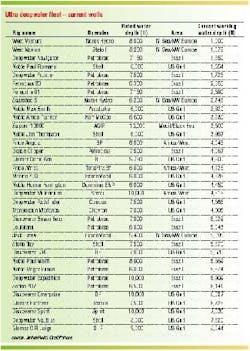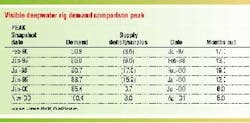DRILLING RIG ECONOMICS: Deepwater rigs drilling in shallow water not being used to full potential
Veronica Murillo
Business Editor
Over $10 billion is spent each year (by the offshore oil and gas industry) in drilling. Of that $10 billion, $2.5 billion is wasted by having a very complex piece of equipment drilling in less demanding environments," stated Ryan Isherwood, President and Chief Operating Officer of OneOffshore. He said the industry needs to create enough transparency and liquidity in the market to reveal operators' drilling needs and available surplus capacity to make an accurate decision on which rigs are appropriate for their projects.
Since November 2000, 12 of the 35 ultra-deepwater rigs (rigs capable of drilling in water depths greater than 5,000 ft) drilled in less than 4,000 ft water depths, including five working in mid-water range (2,000 ft or shallower).
Enough rigs are available to drill ultra-deepwater wells, according to OneOffshore Senior Analyst Janice Rudd at a recent DOT conference (see ref.), but 48% of ultra-deepwater rig time is committed to shallow-water projects this year. Since the beginning of 2000, deepwater rig demand has grown from 85 rig-years to 100 rig-years, according to Rudd's paper. In 1999 and 2000, sublets (or sub-leases) met less than 10% of deepwater demand. More than half of the ultra-deepwater fleet's time was spent in less than 5,000 ft of water. Rudd said operators with long-term contracts on ultra-deepwater rigs need to:
- Swap or sublet time on rigs when less capable rigs can fulfill their requirements
- Oil and gas producers must give up preference for more rig capability than needed, if industry's deepwater drilling plans are to be achieved.
Rig leases and charter rates
Oil companies are looking to contract new rigs with ultra deepwater capability, but while at the same time many rigs of this same class are operating in shallow water. Isherwood and Rudd contend that this has generated a surplus of drilling units in shallow water and reduce charter rates for these rigs. A shortage of units for greater depths results in the creation of less value for oil companies and rig contractors who could have otherwise deployed more rigs in the harshest environments.
Isherwood says some ultra-deepwater rigs are contracted at $250,000 a day, but often, companies could get by with a rig that would only cost $50,000, if the oil and gas producers could discover opportunities to trade beforehand.
In addition to inefficient usage, the charter rates operators pay for rigs vary and suggest a low degree of market transparency. "Industry has a tendency to think they are making fully informed decisions on charter rates, but the data suggests that they don't," Isherwood said. He claims rigs in the Gulf of Mexico experience is an example of this.
OneOffshore looked at drilling rig charter rates over the last two years. The spread between high and low rates for the 300 ft cantilever jackup class averaged 38% in any given month, with some months as high as 67%.
Information technology
Sufficient technology to explore in deepwater is available, however equipment to build that technology is in short supply, the OneOffshore duo contends. Offshore drilling unit contractors have just come through a period over the last 20 years where bloated supply, caused by overbuilding in the mid-1980's, is just now coming into balance with demand.
Oil companies want new rigs again, but rig contractors' balance sheets are limited, in contrast with the oil producers. Rig contractors simply don't have the funds to build new units, while oil companies are making huge commitments, the two point out.
Oil companies contribute to newbuilds by obligating to long term charters so that rig contracting companies can use the commitments to secure necessary financing to build new rigs. It's almost certain oil companies won't have enough drill sites to fully use complex rig's full capabilities on every well, leaving lots of opportunity cost on the table. Oil companies are willing to participate because having a drilling rig available at the proper time can have a significant impact on the value of an oil company's exploration portfolio.
"It's obvious that oil producers won't have enough drill sites to fully use their contracted rigs," Isherwood said. "However, they want to contract for the biggest and best rigs because those units will eventually be needed for deepwater wells. And they can sublet the rigs to other producers when not in use."
Frustrating an oil company's ability to market the rig has been that drilling rig contractors aren't eager to work with oil and gas producers to fulfill their needs efficiently, because at the marketing end of the rig contracting business, the oil producers have become competitors.
Rig costs
Rudd said that adding another ultra-deepwater drilling unit to the rig fleet would likely cost more than $150 million and take 18-24 months to deliver. Under-employed rigs could be made available for rig swaps, as could rigs that would otherwise need to mobilize to another market. An efficient secondary market would provide the information necessary to sublet and swap rigs across water-depth capabilities and geographic markets, Rudd contends. Liquidity in the secondary market could improve by standardizing sublet contracting terms.
Rudd also maintains that rig swaps between geographic markets could also increase effective supply by avoiding mobilizations. For example, Brazil's use of deepwater rigs is 100% and the only floating equipment available in West Africa is in the mid-water range. However, Rudd says that day rates are likely to increase in those areas to attract equipment from the Gulf of Mexico and the North Sea. Rigs capable of working in 5,000 ft or more have been at 100% usage since June 2000, and Rudd contents that fleet optimization will only alleviate the ultra-deepwater rig shortage, not cure it.
In order to guarantee a rig for a high profile, high potential project, operators need to secure a long-term contract on the rig for that requirement, then make use of the rig elsewhere because it is already under contract, Rudd claims.
Newbuilds and upgrades
Additions will likely be made to the ultra-deepwater fleet through a combination of upgrades, conversions, and newbuilds. Rudd states that deepwater drilling projects, stacked up since 1995, were completely different from those in the last cycle of rig newbuilds in the early 1980s. During that period, no new rigs had water depth capabilities over 5,000 ft. Today, rig equipment manufacturers are struggling to bring out new products on time that can go to work immediately.
Rudd said upgrades and conversions are more likely at the beginning of this cycle because there are opportunities with virtually zero opportunity costs. Several individuals in drilling contractor management have shown a preference for upgrades and conversions, yet balance sheets and bad experiences during the last cycle may keep some rig contractors from moving into newbuilds or upgrades.
In November 2000, only three companies - Transocean Sedco Forex, R&B Falcon, and Noble Drilling - had a market capitalization of more than $5 billion, according to Rudd's paper. Diamond Offshore and Noble Drilling have demonstrated preferences for upgrades and conversions over newbuilds and have the fleets to match. Atwood's stated strategy is to focus on the 2,000-6,000 ft water depth market, where newbuilds are less likely to appear, she said.
Reference
Rudd, J., "Deepwater Reality, Ultra Deep Potential: How Equipment Markets Can Intervene," 2000 Deep Offshore Technology Conference, November, 2000, New Orleans.


